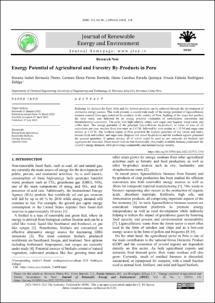Mostrar el registro sencillo del ítem
Energy Potential of Agricultural and Forestry By-Products in Peru
| dc.contributor.author | Bernaola Flores, Roxana Isabel | |
| dc.contributor.author | Flores Barreda, Carmen Elena | |
| dc.contributor.author | Parada Quinayá, Diana Carolina | |
| dc.contributor.author | Rodríguez Zúñiga, Ursula Fabiola | |
| dc.date.accessioned | 2023-11-28T23:06:05Z | |
| dc.date.available | 2023-11-28T23:06:05Z | |
| dc.date.issued | 2023 | |
| dc.identifier.citation | Bernaola Flores, R.I., Flores Barreda, C. E., Parada Quinayá, D. C. and Rodríguez Zuñiga, U. F. (2023). Energy Potential of Agricultural and Forestry By-Products in Peru, 10(1), 1-8. https://doi.org/10.30501/jree.2022.323731.1310 | es_PE |
| dc.identifier.uri | https://hdl.handle.net/20.500.12815/340 | |
| dc.description.abstract | Reducing the demand for fossil fuels and the derived products can be achieved through the development of alternative energy sources. This work presents a countrywide study of the energy potential of lignocellulosic biomass sourced from agro-industrial by-products in the country of Peru. Ranking of the crops that produce the most waste was followed by an energy potential evaluation of carbohydrate conversion and thermochemical conversion. The crops with high calorific values were sugar cane bagasse, wood waste, and coffee husk. The energy potential of the principal lignocellulosic by-products, in terms of tons of oil equivalents per year, resulted from rice straw at 1.45 M, followed by corn residue at 1.13 M and sugar cane residue at 1.10 M. The northern region of Peru generated the highest quantities of rice (straw and husk), banana (husk and rachis), and sugar cane (bagasse and straw) by-products and the southern regions generated the greatest quantities of quinoa residue, all of which could be used as raw materials for biofuels and aggregates for materials. These results indicate that theoretically, this readily available biomass could meet the country's energy demands while promoting sustainability and national energy security. | es_PE |
| dc.format | application/pdf | es_PE |
| dc.language.iso | eng | es_PE |
| dc.publisher | Materials and Energy Research Center | es_PE |
| dc.rights | info:eu-repo/semantics/openAccess | es_PE |
| dc.source | Repositorio Institucional UTEC | es_PE |
| dc.source | Universidad de Ingeniería y Tecnología - UTEC | es_PE |
| dc.subject | Energy from Agriculture | es_PE |
| dc.subject | Renewable Biofuels | es_PE |
| dc.subject | Circular Economy | es_PE |
| dc.subject | Calorific Value | es_PE |
| dc.title | Energy Potential of Agricultural and Forestry By-Products in Peru | es_PE |
| dc.type | info:eu-repo/semantics/article | es_PE |
| dc.subject.ocde | https://purl.org/pe-repo/ocde/ford#1.02.02 | es_PE |
| dc.identifier.doi | https://doi.org/10.30501/jree.2022.323731.1310 | |
| dc.identifier.journal | Journal of Renewable Energy and Environment | es_PE |
| renati.author.orcid | https://orcid.org/0000-0002-3861-7183 | es_PE |
| renati.author.orcid | https://orcid.org/0000-0001-9881-0025 | es_PE |
| renati.author.orcid | https://orcid.org/0000-0002-9928-5127 | es_PE |
| renati.author.orcid | https://orcid.org/0000-0001-5426-9871 | es_PE |

